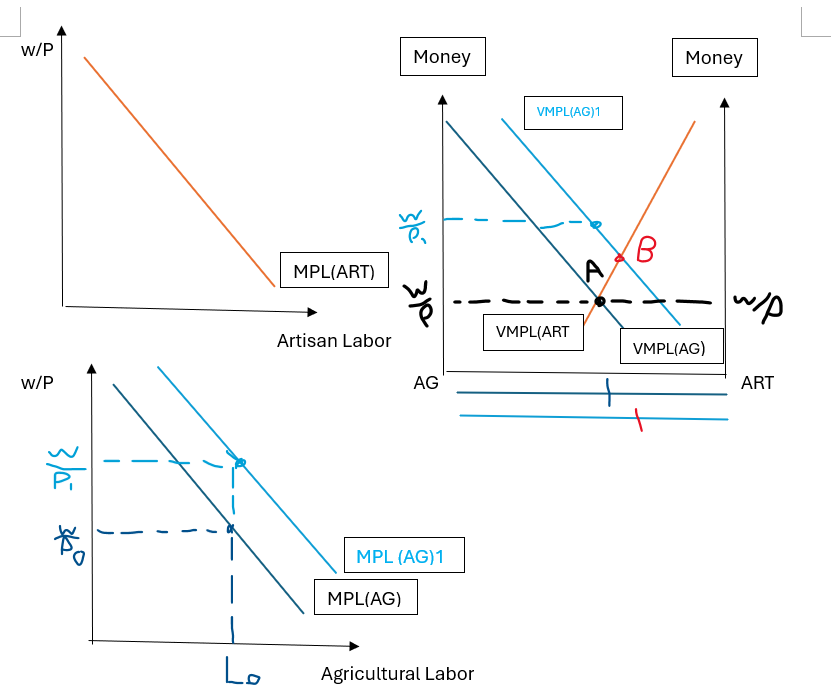Agricultural Revolution
1/12
There's no tags or description
Looks like no tags are added yet.
Name | Mastery | Learn | Test | Matching | Spaced |
|---|
No study sessions yet.
13 Terms
What was the agricultural revolution?
This the revolution following the Black Death in 1350 that improved agricultural production.
What were some of the innovations arising from the agricultural revolution?
-Creating output from "Improved” land (arable land, pasture, meadows)
-Creating Improved land
-Using more workers
They focused on creating output from improved land because income per person rose following the black death. This means that more people were able to afford wool textiles that came from sheep that needed that improved land for grazing. (They also grew Sainfoin on the land for grazing). They also used more workers per field to utilize the land as much as possible (but Marginal Product of labor did fall).
What was the “inclosing” innovation used by Spalsbury Parish (In England) farmers?
“Inclosing” was different in that rather than enclosure it was a partially open and partially fenced off area of land. This created a semi-public and semi-private area that allowed for experimentation of crops (because manor lords allowed copyholders to crop what they wished).
What was the Taston Sainfoin agreement in Spelsbury, how was it innovative?
The Taston agreement was an agreement in which 3 copyholders managed the meadows and when pasturing took place- it was signed by all the copyholders in Taston. This came about from demands from manor lords to grow Sainfoin, because it was used for pasturing. This improved the method of managing the meadows more efficiently as grazing now occurred communally.
What was the 1708 agreement in Spelsbury, how was it innovative?
The 1708 agreement was an agreement that required enclosed land to be utilized and continuously cropped. Communal grazing was also required following harvests. The only difference between this agreement and the Taston Sainfoin one being that copyholders could plant what they wanted- not just exclusively Sainfoin.
What was the 1758 field order, how was it innovative?
This order encouraged equal cropping across all fields by forcing the field to cultivate turnips in an effort to make cultivation an obligation. In this way, the management of the field would be more efficient- collective precedence rather than individual precedence.
What is convertible husbandry, how did convertibly husbandry make farming more efficient?
This is when the land alternates between arable land and pasture. It is more efficient in the sense that land is being improved and used more than before.
Why was enclosure arguably necessary to use the innovations in the industrial revolution?
Enclosure was arguably necessary to utilize the innovations in the industrial revolution because it increased the production of consumer goods. Increased communal grazing led to increased output per improved area which led to more animal product consumer goods (Wool textiles). Field rotation led to the switch between arable and pastureland- utilizing more improved land. The increase in consumer goods would then give rise to urban demand and so on.
Why did the production of consumer goods lead to the industrial revolution?
The aforementioned innovations (field rotation and communal grazing) increased urban demand which gave rise to the production of artisan goods people now had the choice between agricultural and artisanal labor. (Hence the specific factors model). The increase in jobs lead to more people being able to afford wool textiles, eventually forming the middle class that would be the driving force of industrialization.
What would the specific factors model for increased innovation in agriculture look like?
Since innovations in technology have happened, productivity in agricultural labor has risen. As such, MPL of agriculture has shifted to the right and the value of MPL of agriculture has also shifted to the right (price of good being produced x MPL of agricultural labor or artisanal labor equals the VMPL) (P x MPL = VMPL) Equilibrium in wages has moved from point A to point B at a higher wage. However, since we assume that people can freely move between being an artisan and agriculturalist, people are going to be agriculturalists because the wage is higher. (Also for Agriculture it’s real wage/price of wheat, and for artisan it’s real wage/price of cloth).

What is Allen’s overall argument about Enclosing leading to industrialization? (Verify in office hours)
Enclosing → (Communal Grazing + Field Rotation- Innovations) → rise of consumer goods → rise of urban demand→ rise of artisanal labor and craftsmenship → Industrialization
What was the scientific revolution?
This was a period from 1550-1760 in which advancements were made in multiple fields and controlled experimentation was invented. Controlled experimentation being carefully changing 1 potential causal factor and observing the result.
How did the scientific revolution led to the agricultural revolution?
The Scientific revolution led to controlled experimentation and invention of consumer goods. Consumer good perpetuated the increase in urban demand. Urban demand would later led to artisan’s demanding animal products. Artisan demand would let to agriculturalists using controlled experimentation and the invention of the innovations discussed in this chapter (the innovations being the agricultural revolution).